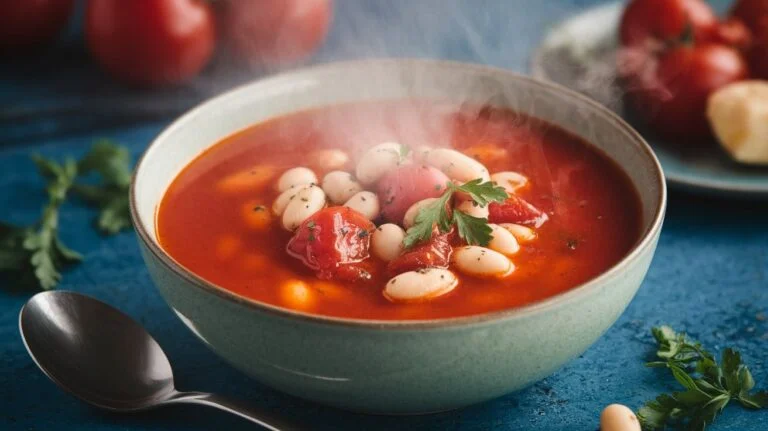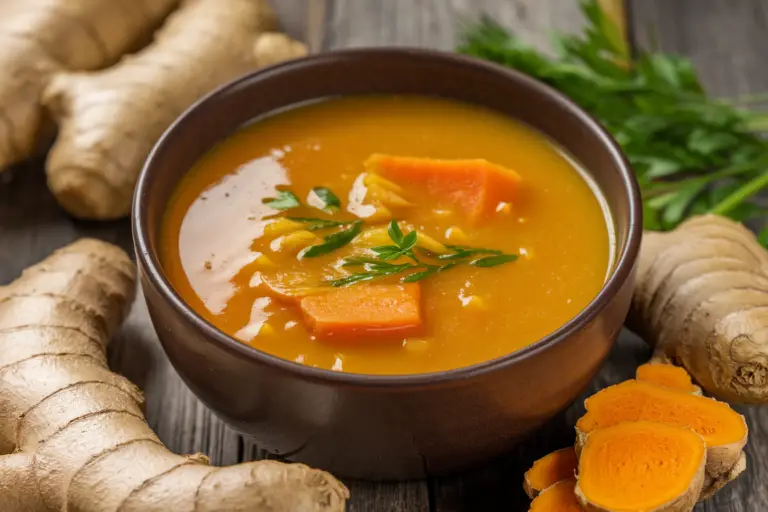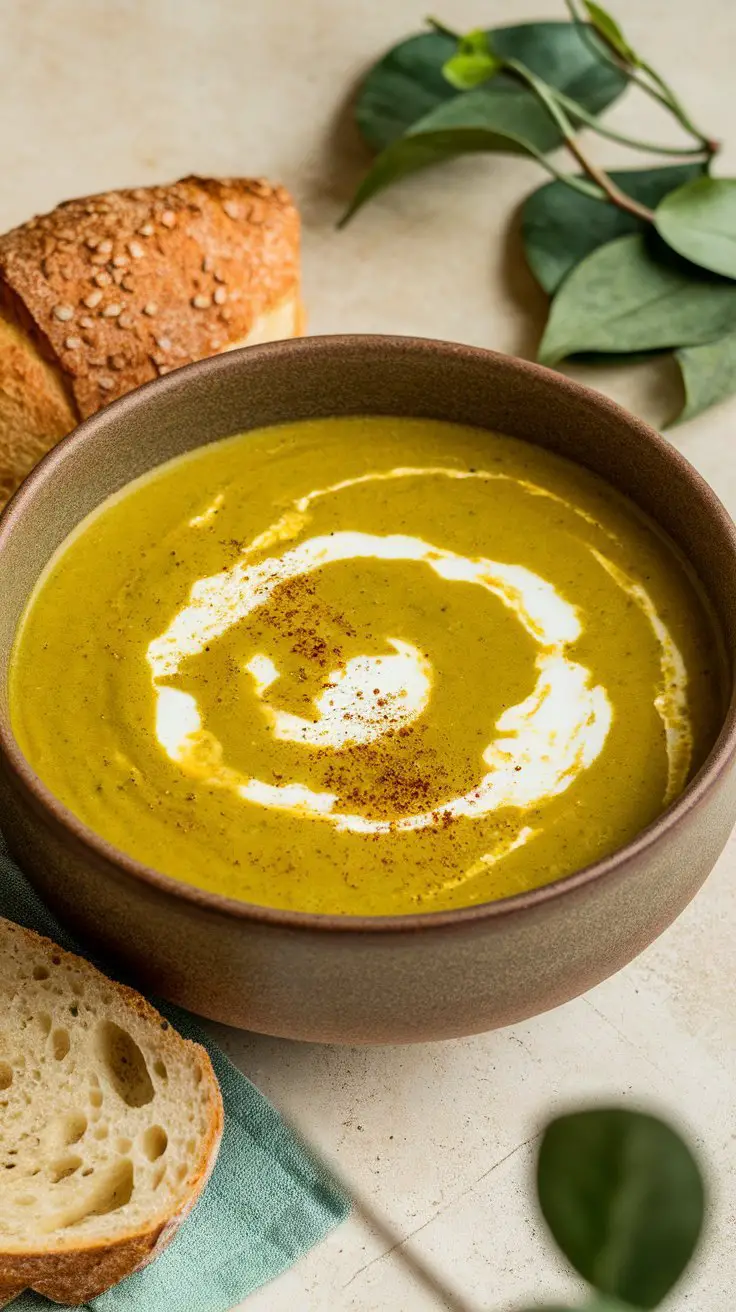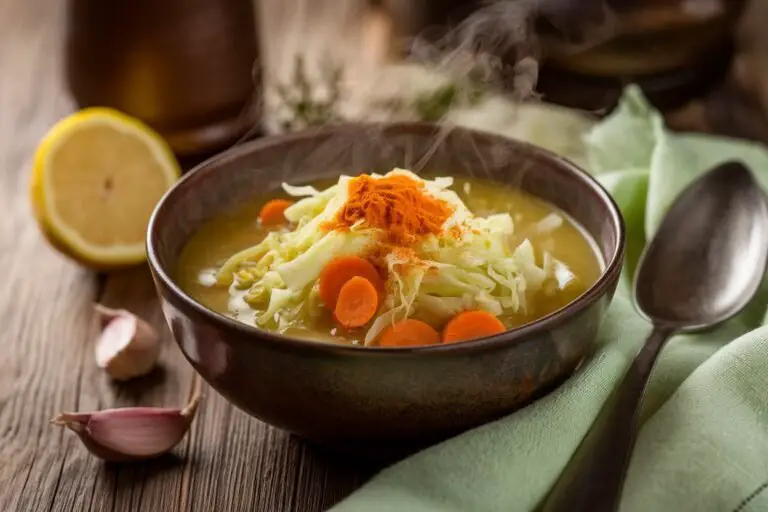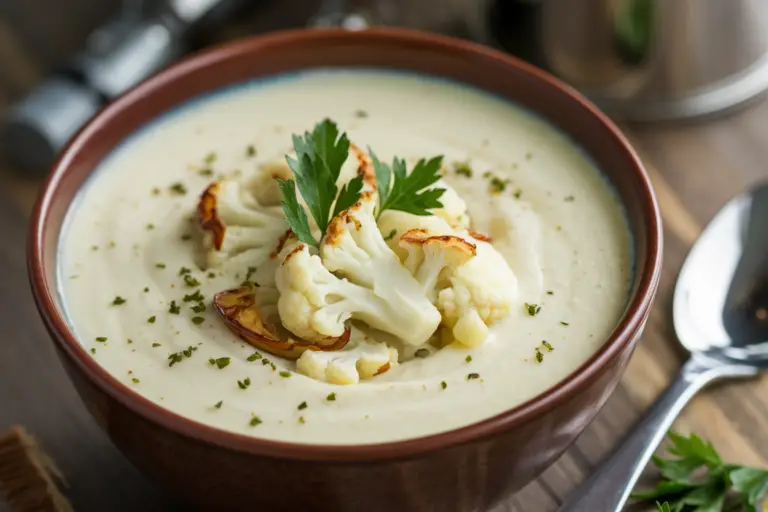Asian-Inspired Ginger-Garlic Broth With Noodles (Low Calorie) – Light, Comforting, And Flavor-Packed
This is the kind of bowl you reach for when you want something cozy but not heavy. A gentle, aromatic broth built on ginger and garlic gives you warmth without weighing you down. Fresh greens, tender noodles, and a clean, savory finish make it feel like a treat any day of the week.
It’s simple enough for a busy weeknight and flexible enough to suit whatever veggies or proteins you have on hand.

Asian-Inspired Ginger-Garlic Broth With Noodles (Low Calorie) - Light, Comforting, And Flavor-Packed
Ingredients
Method
- Prep the aromatics. Peel and slice the ginger. Thinly slice the garlic.Separate scallion whites from greens; chop both and keep separate.
- Toast the flavor base. In a large pot over medium heat, add a splash of water or 1 teaspoon neutral oil. Add ginger, garlic, and scallion whites. Cook 2–3 minutes until fragrant, stirring often to prevent browning.
- Build the broth. Pour in the vegetable or chicken broth.Add soy sauce or tamari. Bring to a gentle boil, then lower to a simmer for 10 minutes to extract flavor.
- Add mushrooms and carrots. Stir in mushrooms and carrot. Simmer 5–7 minutes until just tender.
- Cook the noodles. In a separate pot, cook noodles according to package directions until al dente.Drain and rinse briefly to stop cooking. Tip: Keeping noodles separate helps the broth stay clear and the noodles from getting mushy.
- Add greens and adjust. Stir in bok choy or spinach and cook 1–2 minutes until wilted. Add rice vinegar to brighten. Taste and adjust with more soy or vinegar as needed.A pinch of white pepper is great here.
- Optional protein. Add cubed tofu, shredded cooked chicken, or quick-cooked shrimp for extra protein. Warm through gently.
- Finish with aroma. Stir in 1 teaspoon sesame oil if using. Remove any large ginger slices if you prefer a smoother sip.
- Assemble bowls. Divide noodles into bowls.Ladle hot broth and vegetables over the top. Garnish with scallion greens, a squeeze of lime, herbs, and chili crisp if you like heat.
What Makes This Special
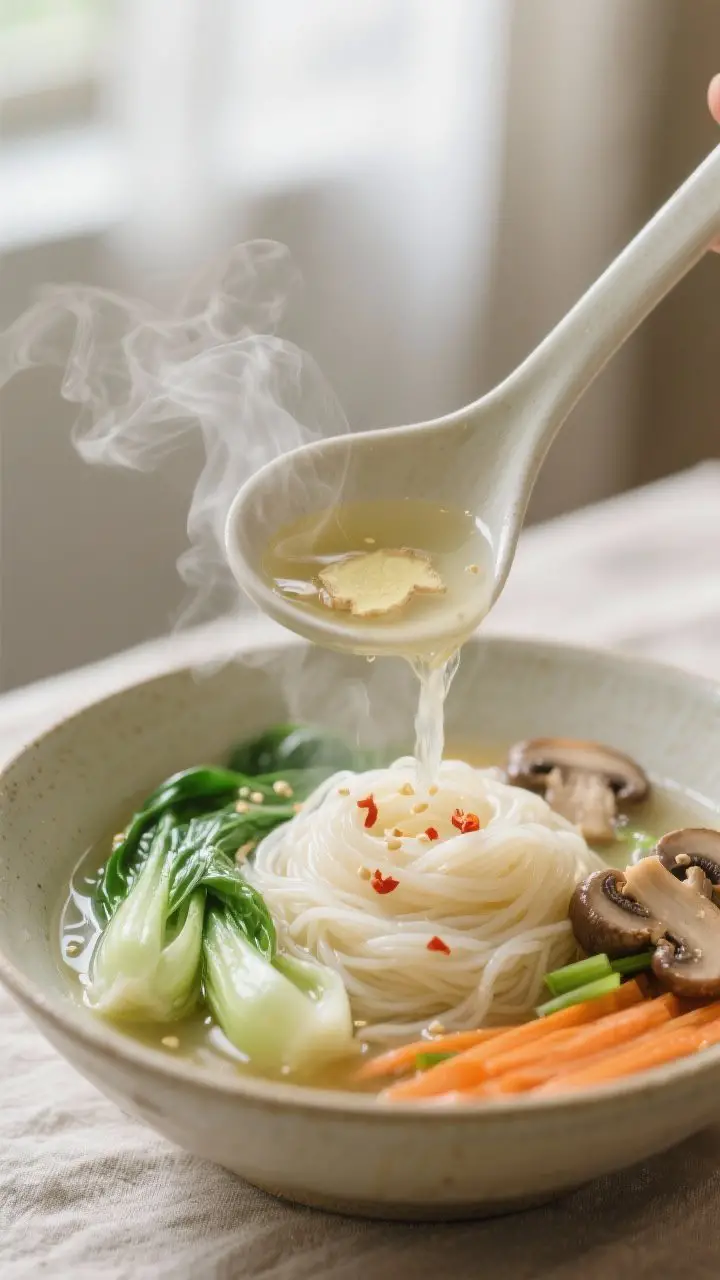
This recipe leans on bold aromatics rather than heavy fats, so you get big flavor at a low calorie count. The broth is layered with ginger, garlic, and scallions, brightened with a splash of rice vinegar, and rounded out with soy sauce or tamari. It’s satisfying thanks to noodles and vegetables, but still light and clean.
📖 Get Access to 50+ Printable Smoothie Recipes Instantly! 🖨️
Boost your health with delicious smoothies! These easy-to-follow printable recipe eBooks are perfect for detoxing, fitness goals, and tasty plant-based living. Available for instant download on Etsy! 🌿✨
You can keep it vegetarian or add lean protein without much extra effort. Most importantly, it tastes like comfort food you can feel good about.
Shopping List
- Low-sodium vegetable broth (or chicken broth), 6 cups
- Fresh ginger, 2–3 inches, sliced or smashed
- Garlic, 6–8 cloves, thinly sliced
- Scallions (green onions), 1 bunch, whites and greens separated
- Soy sauce or tamari, 2–3 tablespoons (low sodium preferred)
- Rice vinegar, 1–2 tablespoons
- Sesame oil, 1 teaspoon (optional for aroma)
- Chili crisp or red pepper flakes, to taste (optional)
- Mushrooms (shiitake, cremini, or mixed), 1–2 cups, sliced
- Bok choy or baby spinach, 2–3 cups, chopped
- Carrot, 1 medium, julienned or thinly sliced
- Noodles: rice noodles, soba, or whole-wheat spaghetti, 6–8 ounces dry
- Optional lean protein: tofu (firm or extra firm), cooked chicken breast, or shrimp
- Lime, 1–2, cut into wedges
- Fresh herbs (cilantro, Thai basil), a small handful (optional)
- White pepper or black pepper, to taste
How to Make It

- Prep the aromatics. Peel and slice the ginger. Thinly slice the garlic.
Separate scallion whites from greens; chop both and keep separate.
- Toast the flavor base. In a large pot over medium heat, add a splash of water or 1 teaspoon neutral oil. Add ginger, garlic, and scallion whites. Cook 2–3 minutes until fragrant, stirring often to prevent browning.
- Build the broth. Pour in the vegetable or chicken broth.
Add soy sauce or tamari. Bring to a gentle boil, then lower to a simmer for 10 minutes to extract flavor.
- Add mushrooms and carrots. Stir in mushrooms and carrot. Simmer 5–7 minutes until just tender.
- Cook the noodles. In a separate pot, cook noodles according to package directions until al dente.
Drain and rinse briefly to stop cooking. Tip: Keeping noodles separate helps the broth stay clear and the noodles from getting mushy.
- Add greens and adjust. Stir in bok choy or spinach and cook 1–2 minutes until wilted. Add rice vinegar to brighten. Taste and adjust with more soy or vinegar as needed.
A pinch of white pepper is great here.
- Optional protein. Add cubed tofu, shredded cooked chicken, or quick-cooked shrimp for extra protein. Warm through gently.
- Finish with aroma. Stir in 1 teaspoon sesame oil if using. Remove any large ginger slices if you prefer a smoother sip.
- Assemble bowls. Divide noodles into bowls.
Ladle hot broth and vegetables over the top. Garnish with scallion greens, a squeeze of lime, herbs, and chili crisp if you like heat.
Keeping It Fresh
Store broth and noodles separately in the fridge for the best texture. The broth holds well for up to 4 days in a sealed container.
Noodles can be rinsed and tossed with a tiny bit of sesame oil or water to keep them from sticking. Reheat broth gently on the stove, then pour over noodles to serve. If you’ve added delicate greens, add fresh greens when reheating to keep the color vibrant.

Benefits of This Recipe
- Low calorie, high comfort. You get a warming, filling bowl without heavy cream or oil.
- Gut-friendly aromatics. Ginger and garlic are known for soothing, bright flavors that support a light, clean taste.
- Hydrating and nourishing. A broth-based meal helps with hydration and delivers fiber from veggies.
- Flexible for diets. Use gluten-free tamari and rice noodles for a gluten-free version.
Keep it vegan with vegetable broth and tofu.
- Quick and weeknight-friendly. Most of the work is simple chopping and simmering, done in under 30 minutes.
What Not to Do
- Don’t boil the aromatics hard. Aggressive heat can make garlic bitter and the broth harsh.
- Don’t overcook the noodles. Mushy noodles will soak up broth and lose their bite.
- Don’t oversalt early. Soy sauce concentrates as it simmers. Season at the end to avoid a salty broth.
- Don’t skip acid. A splash of rice vinegar or lime juice keeps flavors bright and prevents a flat-tasting bowl.
- Don’t crowd the pot with too many strong flavors. Keep the focus on ginger and garlic; let them lead.
Alternatives
- Noodles: Swap rice noodles for soba, udon, or whole-wheat spaghetti. For ultra-low calorie, try shirataki noodles or spiralized zucchini added at the end.
- Broth: Use chicken broth for added richness, or a kombu-based vegetable broth for a deeper umami hit.
- Veggies: Add snow peas, napa cabbage, bean sprouts, or thinly sliced bell peppers.
Keep pieces small so they cook quickly.
- Protein: Silken tofu for a delicate texture, extra-firm tofu for chew, or poached shrimp for lean protein. Leftover rotisserie chicken works in a pinch.
- Heat level: Chili oil, chili crisp, or a touch of gochugaru can bring gentle warmth without overpowering the broth.
- Garnishes: Try toasted nori strips, sesame seeds, or a spoon of miso whisked into a ladle of hot broth off the heat for depth.
FAQ
How many calories are in a serving?
With vegetable broth, lots of greens, mushrooms, and 2 ounces of dry noodles per person, a bowl typically lands around 250–350 calories. If you add tofu or lean chicken, expect closer to 350–450 calories depending on portion size and toppings.
Can I make it ahead?
Yes.
Make the broth and store noodles separately. Reheat the broth and add fresh greens just before serving to keep color and texture bright. Assemble bowls to order for the best results.
What’s the best noodle for this broth?
Rice noodles are light and naturally gluten-free.
Soba adds nuttiness and a bit more protein. Whole-wheat spaghetti works if that’s what you have. The key is stopping at al dente and storing separately.
How do I keep it low sodium?
Use low-sodium broth and low-sodium soy sauce or tamari.
Taste as you go and season with acid and aromatics to boost flavor without extra salt. A squeeze of lime can reduce the need for more soy.
Can I make it spicier?
Absolutely. Add chili crisp, sliced fresh chilies, or a touch of red pepper flakes to the pot.
For a gentle heat, bloom the chili in a teaspoon of oil first, then add to the broth.
What if I don’t have rice vinegar?
Use lime juice, apple cider vinegar, or a mild white wine vinegar. Start with less and adjust to taste. The goal is a clean, bright finish, not a sharp bite.
Will frozen vegetables work?
Yes.
Frozen spinach, peas, or mixed veggies can go in near the end. Add them straight from the freezer and simmer just until heated through so they don’t go mushy.
Can I use miso paste?
Yes, but whisk it into a small ladle of hot broth off the heat to preserve its delicate flavor. Stir this back into the pot at the end for a gentle umami boost.
How can I add more protein without many calories?
Use firm tofu, poached shrimp, or shredded chicken breast.
You can also add edamame or a soft-boiled egg if you’re not strictly keeping calories very low.
What’s the best way to reheat?
Warm the broth gently on the stove until steaming, not boiling. Place noodles in the bowl and pour the hot broth over them. Add fresh greens or herbs to refresh the bowl.
In Conclusion
This Asian-inspired ginger-garlic broth with noodles delivers comfort, clarity, and satisfying flavor without the calorie overload.
It’s quick to make, easy to customize, and kind to your budget and routine. Keep the aromatics front and center, finish with a hit of acid, and enjoy a bowl that feels both nourishing and bright. Whether you keep it simple or dress it up with protein and heat, it’s a reliable, feel-good meal you’ll want on repeat.

